Volcanoes'
impact on Earth
Profits
brought by volcanoes
Volcanic
materials ultimately break down to form some of the most fertile soils on Earth,
cultivation of which fostered and sustained civilizations. People use volcanic
products as construction materials, as abrasive and cleaning agents, and as raw
materials for many chemical and industrial uses. The internal heat associated
with some young volcanic systems has been harnessed to produce geothermal
energy. For example, the electrical energy generated from The Geysers geothermal
field in northern California can meet the present power consumption of the city
of San Francisco. Volcanoes have played a key role in forming and modifying
the planet upon which we live. More than 80 percent of the Earth's surface
(above and below sea level) is of volcanic origin. Gaseous emissions
from volcanic vents over hundreds of millions of years
helped cool off the earth removing heat from its interior and formed the Earth's
earliest oceans and atmosphere, which supplied the ingredients vital to evolve
and sustain life. Over geologic eons, countless volcanic eruptions have produced
mountains, plateaus, and plains, which subsequent erosion and weathering have
sculpted into majestic landscapes and formed fertile soils. Volcanic
materials provide nutrients to the surrounding
soil. Volcanic ash often contains minerals that are beneficial to plants, and if
it is very fine ash it is able to break down quickly and get mixed into the
soil. I suppose another benefit might be the fact that volcanic
slopes are often rather inaccessible, especially if they are steep. Thus they
can provide refuges for rare plants and animals from the ravages of humans and
livestock. volcanic gases are
the source of all the water (and most of the atmosphere) that we have today. The
process of adding to the water and atmosphere is pretty slow, but if it hadn't
been going on for the past 4.5 billion years or so we'd be pretty miserable. Volcanic deposits are also used as building materials.
In the 1960's Robert Bates published Geology of the Industrial Rocks and
Minerals.
He noted that basalt and diabase are quarried in the northeastern and northwest
states. Most of the basalt and diabase is used for crushed stone: concrete
aggregate, road metal, railroad ballast, roofing granules, and riprap. High-denisity
basalt and diabase aggregate is used in the concrete shields of nuclear
reactors. Some diabase is used for dimension stone ("black granite"). Finally,
Pumice, volcanic ash, and perlite are mined in the west.
Pumice and volcanic ash are used as abrasives, mostly in hand soaps and
household cleaners. The finest grades are used to finish silverware, polish
metal parts before electroplating, and for woodworking. Bates reports that in
ancient Rome lime and volcanic ash were mixed to make cement. In modern times
pumice and volcanic ash have been used to make cement for major construction
projects (dams) in California and Oklahoma. Pumice and volcanic ash continue to
be used as lightweight aggregate in concrete, especially precast concrete
blocks. Crushed and ground pumice are also used for loose-fill insulation,
filter aids, poultry litter, soil conditioner, sweeping compound, insecticide
carrier, and blacktop highway dressing. Perlite is volcanic glass (made of
rhyolite) that has incorporated 2-5% water. Perlite expands rapidly when heated.
Perlite is used mostly as aggregate in plaster. Some perlite is used as
aggregate in concrete, especially in precast walls.
Volcano Hazards
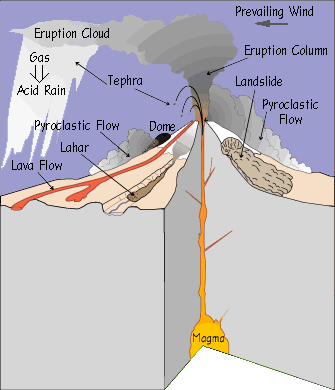 Many kinds of volcanic activity can endanger the
lives of people and property both close to and far away from a volcano.
Most of the activity involves the explosive ejection or flowage of rock
fragments and molten rock in various combinations of hot or cold, wet or
dry, and fast or slow. Some hazards are more severe than others
depending on the size and extent of the event taking place and whether
people or property are in the way. And although most volcano hazards are
triggered directly by an eruption, some occur when a volcano is quiet.
Many kinds of volcanic activity can endanger the
lives of people and property both close to and far away from a volcano.
Most of the activity involves the explosive ejection or flowage of rock
fragments and molten rock in various combinations of hot or cold, wet or
dry, and fast or slow. Some hazards are more severe than others
depending on the size and extent of the event taking place and whether
people or property are in the way. And although most volcano hazards are
triggered directly by an eruption, some occur when a volcano is quiet.
Volcanic eruptions are one of Earth's most dramatic and
violent agents of change. Not only can powerful explosive eruptions drastically
alter land and water for tens of kilometers around a volcano, but tiny liquid
droplets of sulfuric acid erupted into the stratosphere can change our planet's
climate temporarily. Eruptions often force people living near volcanoes to
abandon their land and homes, sometimes forever. Those living farther away are
likely to avoid complete destruction, but their cities and towns, crops,
industrial plants, transportation systems, and electrical grids can still be
damaged by tephra, lahars, and flooding.
Volcanic activity since 1700 A.D. has killed more than
260,000 people, destroyed entire cities and forests, and severely disrupted
local economies for months to years. Even with our improved ability to identify
hazardous areas and warn of impending eruptions, increasing numbers of people
face certain danger. Clearly, scientists face a formidable challenge in
providing reliable and timely warnings of eruptions to so many people at risk.
Volcano
Landslides
What are volcano landslides?
Landslides are large masses of rock and soil that
fall, slide, or flow very rapidly under the force of gravity. These
mixtures of debris move in a wet or dry state, or both. Landslides
commonly originate as massive rockslides or avalanches which
disintegrate during movement into fragments ranging in size from small
particles to enormous blocks hundreds of meters across. If the moving
rock debris is large enough and contains a large content of water and
fine material (typically, >3-5 percent of clay-sized particles), the
landslide may transform into a lahar and flow downwards along the valley
for more than 100
km from a volcano!
Volcano landslides range in size from less than 1
km3 to more than 100 km3. The high velocity
(>100 km/hr) and great momentum of landslides allows them to run up
slopes and to cross valley divides up to several hundred meters high.
For example, the landslide at Mount St. Helens on May 18, 1980, had a
volume of 2.5 km3, reached speeds of 50-80 m/s (180-288
km/hr), and surged up and over a 400 m tall ridge located about 5 km
from the volcano!
How are volcano landslides generated?
Landslides are common on volcanoes because their
massive cones typically rise hundreds to thousands of meters above the
surrounding terrain, and are often weakened by the very process that
created them--the rise and eruption of molten rock. Each time magma moves
toward the surface, overlying rocks are shouldered aside as the molten
rock makes room for itself, often creating internal shear zones or over-steepening one or more sides of the cone. Magma that remains within
the cone releases volcanic gases that partially dissolve in groundwater,
resulting in a hot acidic hydrothermal system that weakens rock by
altering rock minerals to clay. Furthermore, the tremendous mass of
thousands of layers lava and loose fragmented rock debris can lead to
internal faults and fault zones that move frequently as the cone
"settles" under the downward pull of gravity.
These conditions permit a number of factors to
trigger a landslide or to allow part of a volcano's cone to simply
collapse under the influence of gravity:
- intrusion
of magma into a volcano
- explosive
eruptions (magmatic or phreatic--steam-driven explosions)
- large
earthquake directly beneath a volcano or nearby (typically >M5)
- intense
rainfall that saturates a volcano or adjacent tephra-covered
hillslopes with water, especially before or during a large earthquake
Volcanoes are susceptible to landslides for several
reasons. Their cones are steep and often rise several thousand meters above the
surrounding land. They are built layer upon layer of weakly consolidated and
brittle rock debris. Because of the frequent intrusion of magma into their cones
and the shear mass of lava that form their cones, internal faults or shear zones
commonly develop. Finally, hot, acid-rich water commonly circulates throughout
the cone to form an extensive hydrothermal system. Over time, this hot water
changes hard volcanic rocks to weak, muddy and clay-rich material. A volcano
with a hydrothermal system is like a house infested with termites--the house
gradually weakens to the point that it may collapse. The collapse of a volcano,
and the resulting lahar, are natural, expectable events during its life history
and long after it stops erupting.
The collapse or "flank failure" of a volcano
will generate a fast-moving landslide that usually transforms into a lahar after
traveling a few kilometers. Depending on the size of the landslide, its water
content, and extent to which the volcano's rocks have been weakened and turned
into clay by a hydrothermal system, the resulting lahar may travel more than 100
km downstream. Such large muddy lahars are extremely dangerous.
Effects of volcano landslides
A landslide typically destroys everything in its
path and may generate a variety of related activity. Historically,
landslides have caused explosive eruptions, buried river valleys with tens
of meters of rock debris, generated lahars, triggered waves and tsunami,
and created deep horseshoe-shaped craters.
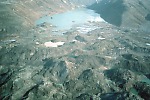 By removing a large part of a volcano's cone, a
landslide may abruptly decrease pressure on the shallow magmatic and
hydrothermal systems, which can generate explosions ranging from a small
steam explosion to large steam- and magma-driven directed blasts. A large
landslide often buries valleys with tens to hundreds of meters of rock
debris, forming a chaotic landscape marked by dozens of small hills and
closed depressions. If the deposit is thick enough, it may dam tributary
streams to form lakes in the subsequent days to months; the lakes may
eventually drain catastrophically and generate lahars and floods
downstream.
By removing a large part of a volcano's cone, a
landslide may abruptly decrease pressure on the shallow magmatic and
hydrothermal systems, which can generate explosions ranging from a small
steam explosion to large steam- and magma-driven directed blasts. A large
landslide often buries valleys with tens to hundreds of meters of rock
debris, forming a chaotic landscape marked by dozens of small hills and
closed depressions. If the deposit is thick enough, it may dam tributary
streams to form lakes in the subsequent days to months; the lakes may
eventually drain catastrophically and generate lahars and floods
downstream.
Coldwater Lake, blocked by landslide deposit, Mount St. Helens, Washington
Landslides also generate some of the largest and
most deadly lahars, either by transforming directly into lahars or, after
it stops moving, from dewatering of the deposit. Historically, however,
the most deadly volcano landslide occurred in 1792 when sliding debris
from Mt. Mayuyama near Unzen Volcano in Japan slammed into the Ariaka Sea and
generated a wave on the opposite side that killed nearly 15,000 people.
On a volcano, landslides typically carve deep gashes
into its cone or create large horseshoe-shaped craters hundreds of meters
deep and more than a kilometer in width.
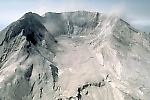 Horseshoe-shaped crater of Mount St. Helens, Washington
Horseshoe-shaped crater of Mount St. Helens, Washington
Lahar
What is a
Lahar?
Lahar is an Indonesian term that describes a hot or cold
mixture of water and rock fragments flowing down the slopes of a volcano and
(or) river valleys. When moving, a lahar looks like a mass of wet concrete that
carries rock debris ranging in size from clay to boulders more than 10 m in
diameter. Lahars vary in size and speed. Small lahars less than a few meters
wide and several centimeters deep may flow a few meters per second. Large lahars
hundreds of meters wide and tens of meters deep can flow several tens of meters
per second--much too fast for people to outrun.
As a lahar rushes downstream from a volcano, its size,
speed, and the amount of water and rock debris it carries constantly change. The
beginning surge of water and rock debris often erodes rocks and vegetation from
the side of a volcano and along the river valley it enters. This initial flow
can also incorporate water from melting snow and ice (if present) and the river
it overruns. By eroding rock debris and incorporating additional water, lahars
can easily grow to more than 10 times their initial size. But as a lahar moves
farther away from a volcano, it will eventually begin to lose its heavy load of
sediment and decrease in size.
Large muddy lahars commonly begin as volcanic
landslides. Part of a volcano may suddenly break loose under the
constant pull of gravity, especially (1) during a large earthquake that
strongly shakes the ground; (2) following a period of heavy rains that
saturate the ground; (3) when magma rises into the core of a volcano and
wedges the cone apart; or (4) during a sideways-directed explosion that
rips through one or more sides of a volcano.
Numerous terms are used by scientists to describe the
properties of lahars (for example, mudflows, debris flows, hyperconcentrated
flows, and cohesive and non-cohesive flows).
What triggers a
lahar?
Eruptions may trigger one or more lahars directly by
quickly melting snow and ice on a volcano or ejecting water from a crater lake.
More often, lahars are formed by intense rainfall during or after an
eruption--rainwater can easily erode loose volcanic rock and soil on hillsides
and in river valleys. Some of the largest lahars begin as landslides of
saturated and hydrothermally altered rock on the flank of a volcano or adjacent
hillslopes. Landslides are triggered by eruptions, earthquakes, precipitation,
or the unceasing pull of gravity on the volcano.
Lahars almost always occur on or near
stratovolcanoes because these volcanoes tend to erupt explosively and
their tall, steep cones are either snow covered, topped with a crater
lake, constructed of weakly consolidated rock debris that is easily
eroded, or internally weakened by hot hyrothermal fluids. Lahars are also
common from the snow- and ice-covered shield volcanoes in Iceland where
eruptions of fluid basalt lava frequently occur beneath huge glaciers
Effects of lahars
Lahars racing down river valleys and spreading across
flood plains tens of kilometers downstream from a volcano often cause serious
economic and environmental damage. The direct impact of a lahar's turbulent flow
front or from the boulders and logs carried by the lahar can easily crush,
abrade, or shear off at ground level just about anything in the path of a lahar.
Even if not crushed or carried away by the force of a lahar, buildings and
valuable land may become partially or completely buried by one or more
cement-like layers of rock debris. By destroying bridges and key roads, lahars
can also trap people in areas vulnerable to other hazardous volcanic activity,
especially if the lahars leave deposits that are too deep, too soft, or too hot
to cross.
After a volcanic eruption, the erosion of new loose
volcanic deposits in the headwaters of rivers can lead to severe flooding and
extremely high rates of sedimentation in areas far downstream from a volcano.
Over a period of weeks to years, post-eruption lahars and high-sediment
discharges triggered by intense rainfall frequently deposit rock debris that can
bury entire towns and valuable agricultural land. Such lahar deposits may also
block tributary stream valleys. As the area behind the blockage fills with
water, areas upstream become inundated. If the lake is large enough and it
eventually overtops or breaks through the lahar blockage, a sudden flood or a
lahar may bury even more communities and valuable property downstream from the
tributary.
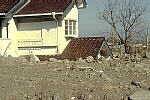 House partially buried by lahar deposits downstream from Unzen Volcano, Japan
House partially buried by lahar deposits downstream from Unzen Volcano, Japan
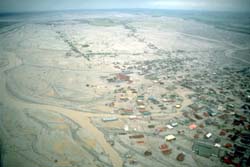
Community
After Lake Breakout-- Lahars from September 1994 though
and after the date of this photograph buried Bacolor to depths of 5 meters
in the town and more than 10 meters in some outlying villages.
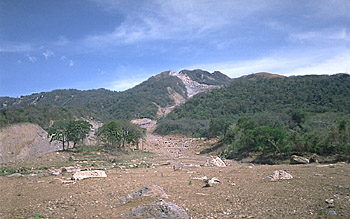
Lahars Triggered
by Sudden Landslides at Volcanoes--
During the day of peak rainfall
from Hurricane Mitch on October 30, 1998, part of Casita Volcano
collapsed to form a landslide (note scar at top of volcano). The sliding
debris quickly transformed into a lahar that eroded rocks and vegetation
from along the stream channel, destroyed two towns, and killed more than
2,000 people. In this photograph, the erosive power of landslides and
lahars is clearly visible (note areas devoid of vegetation)
Terms Often Used
to Refer to Lahars
Scientists often use more specific terms than lahar when
referring to moving masses of water and rock debris. The various terms are
defined by the relative amounts of rock debris (sediment) and water in the flow,
often as a ratio of sediment to water. And because a flow of water and sediment
can erode or deposit sediment and incorporate water along its journey
downstream, this ratio changes with increasing distance from a volcano. So, for
even a single flow, scientists will commonly use different terms when describing
the flow.
Debris Flow--
Dense flows that consist of a relatively high percentage
of coarse rock particles are debris flows. The size of sediment transported by
debris flows ranges in size from clay and silt (less than 0.06 mm) to boulders
as large as 10 m in diameter. A typical debris flow consists of about 2 parts
sediment for every one part water. Thus, debris flows may consist of more than
80 percent sediment by weight!
Mudflow-- A debris flow composed of relatively small rock particles,
dominantly sand and silt-sized particles (less than 2 mm in diameter), is often
called a mudflow. Even though mudflows can transport large boulders and can have
sediment concentrations as great as debris flows, their sediment composition
typically consists of at least 50 percent sand, silt, and clay-size particles
("mud" refers to silt- and clay-size particles). Mudflows
commonly occur on volcanoes with large deposits of ice and snow on their
summits. Mudflows typically begin with the rapid melting of a large amount of
ice. The melting may be caused by an eruption or simply by friction in an ice
avalanche that has broken free because of an earthquake or collapse of an
overloaded ice mass. As the melt water flows down the volcano's flank, it mixes
with the usually abundant loose soil and ash to form a muddy liquid about the
consistency of wet cement. The mud follows stream and river valleys down and
away from the volcano to become a fast-moving (40-50 mph) wall of mud that will
carry away anything in its path. Mudflows at Mount St. Helens carried huge trucks
and machinery many miles and tore bridges and houses from their foundations. A mudflow
roared down a river valley on the side of Nevado del Ruiz in Columbia in 1985
and swept through a town of 25,000 people, killing nearly everyone and leaving
nothing standing. Mudflows
are a particular problem on high volcanoes that have glaciers on them, such as
those in the Andes Mountains in South America and the Cascades in the western
United States. As you might expect, the larger
the amount of ice available to melt, the larger the potential mudflows. About
3.5 billion cubic feet of ice melted during the 1980 Mount St. Helens eruption.
Mudflows from that eruption flowed many tens of miles down local river
drainages. Mudflows around Mount Rainier, with its much larger mass of glaciers,
are an ongoing problem. Some Rainier mudflows have traveled 50 to 100 miles away
from the mountain. Mudflows are a significant danger during eruptions, because
the heat from the inside of the mountain or from falling hot ash is capable of
melting large amounts of ice. However, mudflows can also occur when there is no
eruption. An earthquake may shake off a mass of ice that melts because of
friction as it rolls down the mountain, mixing with loose material to make a
mudflow. A heavy snow fall or rapid spring melt may trigger a burst of ice or
water from a glacier that may also form a mudflow.
Hyperconcentrated Streamflow--
A flow containing between 40 and 80 percent sediment by
weight is often referred to as hyperconcentrated streamflow. Debris flows and
mudflows represent the most dense and concentrated mixtures of flowing sediment
and water; they commonly are composed of more than 80 percent sediment by
weight. Normal streamflow, which may contain as much as 40 percent sediment by
weight, is the least dense and concentrated mixture of flowing sediment and
water. Hyperconcentrated flows are finer grained than debris flows and mudflows,
usually consisting of predominantly of sand-size particles. As a debris flow or
mudflow moves down a river valley, they will eventually become more dilute by
mixing with water in the river and by losing some of the sediment. When the
percentage of sediment by weight drops below 80 percent, the flow transforms
into hyperconcentrate streamflow.
Cohesive Lahars--
Debris flows or mudflows that contain more than 3 to 5
percent of clay-size sediment are sometimes referred to as cohesive lahars.
Scientists may sometimes conclude that a relatively high concentration of clay
in these flows indicates it began as a large landslide from the flank of a
volcano. The interior parts of many volcanoes have been hydrothermally altered
and consist of many clay particles.
Non-cohesive Lahars--
Debris flows or mudflows that contain less than 3 to 5
percent of clay-size sediment are sometimes referred to as non-cohesive lahars.
Such a relatively low proportion of clay in this volcanic debris is considered
by some scientists to be evidence that the lahar did not originate as a volcanic
landslide, but rather in another way. For example, by the mixing of water melted
from snow and ice with volcanic debris.
Volcanic
Gases
Volcanic
gases are the driving force of eruptions
Magma
contains dissolved gases that are released into the atmosphere during
eruptions. Gases are also released from magma that either remains below
ground or is rising toward the surface. In such cases, gases may escape
continuously into the atmosphere from the soil, volcanic vents,
fumaroles, and hydrothermal systems.
At high
pressures deep beneath the earth's surface, volcanic gases are dissolved
in molten rock. But as magma rises toward the surface where the pressure
is lower, gases held in the melt begin to form tiny bubbles. The
increasing volume taken up by gas bubbles makes the magma less dense
than the surrounding rock, which may allow the magma to continue its
upward journey. Closer to the surface, the bubbles increase in number
and size so that the gas volume may exceed the melt volume in the magma,
creating a magma foam. The rapidly expanding gas bubbles of the foam can
lead to explosive eruptions in which the melt is fragmented into pieces
of volcanic rock, known as tephra. If the molten rock is not fragmented
by explosive activity, a lava flow will be generated.
Together
with the tephra and entrained air, volcanic gases can rise tens of
kilometers into Earth's atmosphere during large explosive eruptions.
Once airborne, the prevailing winds may blow the eruption cloud hundreds
to thousands of kilometers from a volcano. The gases spread from an
erupting vent primarily as acid aerosols (tiny acid droplets), compounds
attached to tephra particles, and microscopic salt particles.
Volcanic gases undergo a
tremendous increase in volume when magma rises to the Earth's surface
and erupts. For example, consider what happens if one cubic meter of 900°C
rhyolite magma containing five percent by weight of dissolved water were
suddenly brought from depth to the surface. The one cubic meter of magma
now would occupy a volume of 670 m3 as a mixture of water
vapor and magma at atmospheric pressure! The one meter cube at depth would increase to 8.75 m
on each side at the surface. Such enormous expansion of volcanic gases,
primarily water, is the main driving force of explosive eruptions.
|
Volcano
Tectonic Style
Temperature
|
Kilauea
Summit
Hot Spot
1170°C
|
Erta`
Ale
Divergent Plate
1130°C
|
Momotombo
Convergent Plate
820°C
|
|
H20
|
37.1
|
77.2
|
97.1
|
|
C02
|
48.9
|
11.3
|
1.44
|
|
S02
|
11.8
|
8.34
|
0.50
|
|
H2
|
0.49
|
1.39
|
0.70
|
|
CO
|
1.51
|
0.44
|
0.01
|
|
H2S
|
0.04
|
0.68
|
0.23
|
|
HCl
|
0.08
|
0.42
|
2.89
|
|
HF
|
---
|
---
|
0.26
|
Types of volcanic gases
The most abundant gas typically released into the
atmosphere from volcanic systems is water vapor (H20),
followed by carbon dioxide (C02)
and sulfur dioxide (S02).
Volcanoes also release smaller amounts of others gases, including hydrogen
sulfide (H2S),
hydrogen (H2),
carbon monoxide (CO), hydrogen chloride (HCL), hydrogen fluoride (HF), and
helium (He). There is a table of volcanic gas compositions, in volume percent concentrations
on the left.
Potential effects of volcanic gases
The volcanic gases that pose the
greatest potential hazard to people, animals, agriculture, and property are sulfur
dioxide, carbon
dioxide, and hydrogen
fluoride. Locally, sulfur dioxide gas can lead to acid rain and air
pollution downwind from a volcano. Globally, large explosive eruptions that
inject a tremendous volume of sulfur aerosols into the stratosphere can lead to
lower surface temperatures and promote depletion of the Earth's ozone layer.
Because carbon dioxide gas is heavier than air, the gas may flow into in
low-lying areas and collect in the soil. The concentration of carbon dioxide gas
in these areas can be lethal to people, animals, and vegetation. A few historic
eruptions have released sufficient fluorine-compounds to deform or kill animals
that grazed on vegetation coated with volcanic ash; fluorine compounds tend to
become concentrated on fine-grained ash particles, which can be ingested by
animals.
Sulfur dioxide (SO2)--
The effects of SO2
on people and the environment vary widely depending on the amount of gas a
volcano emits into the atmosphere, whether the gas is injected into the
troposphere or stratosphere and the regional or global wind and weather
pattern that disperses the gas. Sulfur dioxide (SO2)
is a colorless gas with a pungent odor that irritates skin and the tissues and
mucous membranes of the eyes, nose, and throat. Sulfur dioxide chiefly affects
upper respiratory tract and bronchi. The World Health Organization recommends a
concentration of no greater than 0.5 ppm over 24 hours for maximum exposure. A
concentration of 6-12 ppm can cause immediate irritation of the nose and throat;
20 ppm can cause eye irritation; 10,000 ppm will irritate moist skin within
minutes.
Emission rates of SO2
from an active volcano range from <20 tonnes/day to >10 million tonnes/day
according to the style of volcanic activity and type and volume of magma
involved. For example, the large explosive eruption of Mount Pinatubo on 15 June
1991 expelled 3-5 km 3 of dacite magma and injected about 17
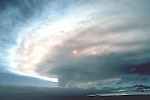 million
tonnes of SO2
into the stratosphere. The sulfur aerosols resulted in a 0.5-0.6°C
cooling of the Earth's surface in the Northern Hemisphere. The sulfate aerosols
also accelerated chemical reactions that, together with the increased
stratospheric chlorine levels from human-made chlorofluorocarbon (CFC)
pollution, destroyed ozone and led to some of the lowest ozone levels ever
observed in the atmosphere. Downwind from the vent, acid rain and air pollution
is a persistent health problem when the volcano is erupting.
million
tonnes of SO2
into the stratosphere. The sulfur aerosols resulted in a 0.5-0.6°C
cooling of the Earth's surface in the Northern Hemisphere. The sulfate aerosols
also accelerated chemical reactions that, together with the increased
stratospheric chlorine levels from human-made chlorofluorocarbon (CFC)
pollution, destroyed ozone and led to some of the lowest ozone levels ever
observed in the atmosphere. Downwind from the vent, acid rain and air pollution
is a persistent health problem when the volcano is erupting.
Sulfur
dioxide gas creates air pollution in Hawai'i
Eruptions of Kilauea Volcano release large quantities of sulfur dioxide
gas into the atmosphere that can lead to volcanic air pollution on the
Island of Hawaii. Sulfur dioxide gas reacts chemically with sunlight,
oxygen, dust particles, and water to form volcanic smog known as vog.
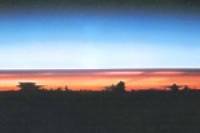 Measurements from recent eruptions such as Mount St. Helens, Washington
(1980), El Chichon, Mexico (1982), and Mount Pinatubo, Philippines (1991),
clearly show the importance of sulfur aerosols in modifying climate,
warming the stratosphere, and cooling the troposphere. Research has also
shown that the liquid drops of sulfuric acid promote the destruction of
the Earth's ozone layer.
Measurements from recent eruptions such as Mount St. Helens, Washington
(1980), El Chichon, Mexico (1982), and Mount Pinatubo, Philippines (1991),
clearly show the importance of sulfur aerosols in modifying climate,
warming the stratosphere, and cooling the troposphere. Research has also
shown that the liquid drops of sulfuric acid promote the destruction of
the Earth's ozone layer.
Hydrogen sulfide (H2S)--
Hydrogen sulfide (H2S)
is a colorless, flammable gas with a strong offensive odor. It is sometimes
referred to as sewer gas. At low concentrations it can irritate the eyes and
acts as a depressant; at high concentrations it can cause irritation of the
upper respiratory tract and, during long exposure, pulmonary edema. A 30-minute
exposure to 500 ppm results in headache, dizziness, excitement, staggering gait,
and diarrhea, followed sometimes by bronchitis or bronchopneumonia.
Carbon dioxide (CO2)--
Volcanoes release more than 130 million tonnes of CO2
into the atmosphere every year. This colorless, odorless gas usually does not
pose a direct hazard to life because it typically becomes diluted to low
concentrations very quickly whether it is released continuously from the ground
or during episodic eruptions. But in certain circumstances, CO2
may become concentrated at levels lethal to people and animals. Carbon dioxide
gas is heavier than air and the gas can flow into in low-lying areas; breathing
air with more than 30% CO2
can quickly induce unconsciousness and cause death. In volcanic or other areas
where CO2
emissions occur, it is important to avoid small depressions and low areas that
might be CO2
traps. The boundary between air and lethal gas can be extremely sharp; even a
single step upslope may be adequate to escape death.
When
a burning piece of wood is lowered into a hole that has a high
concentration of CO2, the fire goes out. Such a condition
can be lethal to people and animals.
Air with 5% CO2
causes perceptible increased respiration; 6-10% results in shortness of
breath, headaches, dizziness, sweating, and general restlessness; 10-15%
causes impaired coordination and abrupt muscle contractions; 20-30%
causes loss of consciousness and convulsions; over 30% can cause death!
Scientists have calculated that volcanoes emit between about 130-230 million
tonnes (145-255 million tons) of CO2
into the atmosphere every year. This estimate includes both subaerial and submarine volcanoes,
about in equal amounts. Emissions of CO2
by human activities, including fossil fuel burning, cement production, and gas
flaring, amount to about 22 billion tonnes per year (24 billion tons). Human
activities release more than 150 times the amount of CO2
emitted by volcanoes--the equivalent of nearly 17,000 additional volcanoes like
Kilauea (Kilauea emits about 13.2 million tonnes/year)!
Hydrogen Chloride
(HCl)-- Chlorine gas is emitted from volcanoes in the form of
hydrochloric acid (HCl). Exposure to the gas irritates mucous membranes of the
eyes and respiratory tract. Concentrations over 35 ppm cause irritation of the
throat after short exposure; >100 ppm results in pulmonary edema, and often
laryngeal spasm. It also causes acid rain downwind from volcanoes because HCl is
extremely soluble in condensing water droplets and it is a very "strong
acid" (it dissociates extensively to give H+ ions in the
droplets).--
Hydrogen Fluoride
(HF)-- Fluorine is a pale yellow gas that attaches to fine ash
particles, coats grass, and pollutes streams and lakes. Exposure to this
powerful caustic irritant can cause conjunctivitis, skin irritation, bone
degeneration and mottling of teeth. Excess fluorine results in a significant
cause of death and injury in livestock during ash eruptions. Even in areas that
receive just a millimeter of ash, poisoning can occur where the fluorine content
of dried grass exceeds 250 ppm. Animals that eat grass coated with
fluorine-tainted ash are poisoned. Small amounts of fluorine can be beneficial,
but excess fluorine causes fluorisis, an affliction that eventually kills
animals by destroying their bones. It also promotes acid rain effects downwind
of volcanoes, like HCl.
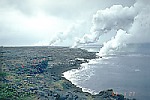 Secondary Gas Emissions
(Lava haze or laze)-- Another type of gas release occurs when lava flows reach
the ocean. Extreme heat from molten lava boils and vaporizes seawater, leading
to a series of chemical reactions. The boiling and reactions produce a large
white plume, locally known as lava haze or laze, containing a mixture of
hydrochloric acid and concentrated seawater.
Secondary Gas Emissions
(Lava haze or laze)-- Another type of gas release occurs when lava flows reach
the ocean. Extreme heat from molten lava boils and vaporizes seawater, leading
to a series of chemical reactions. The boiling and reactions produce a large
white plume, locally known as lava haze or laze, containing a mixture of
hydrochloric acid and concentrated seawater.
Hydrochloric acid forms when lava enters the ocean boiling and vaporizing the
sea water. Chloride in the sea salt combines with hydrogen in the water to form
hydrochloric acid in the plume. This is a short-lived local phenomenon that only
affects people or vegetation directly under the plume.
Lava
Flows
What are Lava Flows?
Lava flows are streams of molten rock that pour or
ooze from an erupting vent and are probably the best known volcanic
hazard. Lava is erupted during either non-explosive
activity or explosive lava fountains. Lava flows destroy everything in
their path, but most move slowly enough that people can move out of the
way. The speed at which lava moves across the ground depends on several
factors, including the type of lava erupted and its viscosity, the steepness of the ground over which it
travels, whether the lava
flows as a broad sheet, through a confined channel, or down a lava tube,
and the rate of lava production at the vent. Fluid basalt flows can extend tens of kilometers
from an erupting vent. The leading edges of  basalt flows can travel as
fast as 10 km/hour on steep slopes but they typically advance less than
1 km/hour on gentle slopes. But when basalt lava flows are confined
within a channel or lava tube on a steep slope, the main body of the
flow can reach velocities >30 km/hour. Viscous andesite flows move only a few kilometers
per hour and rarely extend more than 8 km from their
vents. Viscous
dacite and rhyolite flows often form steep-sided mounds called lava
domes over an erupting vent. Lava domes often grow by the extrusion of
many individual flows >30 m thick over a period of several months or
years. Such flows will overlap one another and typically move less than
a few meters per hour.
basalt flows can travel as
fast as 10 km/hour on steep slopes but they typically advance less than
1 km/hour on gentle slopes. But when basalt lava flows are confined
within a channel or lava tube on a steep slope, the main body of the
flow can reach velocities >30 km/hour. Viscous andesite flows move only a few kilometers
per hour and rarely extend more than 8 km from their
vents. Viscous
dacite and rhyolite flows often form steep-sided mounds called lava
domes over an erupting vent. Lava domes often grow by the extrusion of
many individual flows >30 m thick over a period of several months or
years. Such flows will overlap one another and typically move less than
a few meters per hour.
Fluid
basalt lava flow, Mauna Loa, Hawaii
Effects of Lava Flows
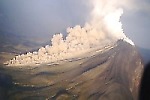 Everything in the path of an advancing lava flow
will be knocked over, surrounded, or buried by lava, or ignited by the
extremely hot temperature of lava. When lava erupts beneath a glacier or
flows over snow and ice, meltwater from the ice and snow can result in
far-reaching lahars. If lava enters a body of water or water enters a
lava tube, the water may boil violently and cause an explosive shower of
molten spatter over a wide area. Methane
gas is produced as lava buries vegetation, can migrate in subsurface
voids and explode when heated. Thick viscous lava flows, especially
those that build a dome, can collapse to form fast-moving pyroclastic
flows.
Everything in the path of an advancing lava flow
will be knocked over, surrounded, or buried by lava, or ignited by the
extremely hot temperature of lava. When lava erupts beneath a glacier or
flows over snow and ice, meltwater from the ice and snow can result in
far-reaching lahars. If lava enters a body of water or water enters a
lava tube, the water may boil violently and cause an explosive shower of
molten spatter over a wide area. Methane
gas is produced as lava buries vegetation, can migrate in subsurface
voids and explode when heated. Thick viscous lava flows, especially
those that build a dome, can collapse to form fast-moving pyroclastic
flows.
Deaths caused directly by lava flows are uncommon because
most move slowly enough that people can move out the way easily and flows
usually don't travel far from the vent. Death and injury can result when
onlookers approach an advancing lava flow too closely or their retreat is cut
off by other flows. Deaths attributed to lava flows are often due to related
causes, such as explosions when lava interacts with water, the collapse of an
active lava delta, asphyxiation due to accompanying toxic gases, pyroclastic
flows from a collapsing dome, and lahars from meltwater.
Other natural phenomena such as hurricanes, tornadoes,
tsunami, fires, and earthquakes often destroy buildings, agricultural crops, and
homes, but the owner(s) can usually rebuild or repair structures and their
businesses in the same location. Lava flows, however, can bury homes and
agricultural land under tens of meters of hardened black rock; landmarks and
property lines become obscured by a vast, new hummocky landscape. People are
rarely able to use land buried by lava flows or sell it for more than a small
fraction of its previous worth.
Pyroclastic
Flows
What
are pyroclastic flows?
Pyroclastic
flows are high-density mixtures of hot, dry rock fragments and hot gases
that move away from the vent that erupted them at high speeds. They may
result from the explosive eruption of molten or solid rock fragments, or
both. They may also result from the nonexplosive eruption of lava when
parts of dome or a thick lava flow collapses down a steep slope. Most
pyroclastic flows consist of two parts: a basal flow of coarse fragments
that moves along the ground, and a turbulent cloud of ash that rises
above the basal flow. Ash may fall from this cloud over a wide area
downwind from the pyroclastic flow. Here is a QuickTime
video of pyroclastic flow (1.79 M).
eruption of molten or solid rock fragments, or
both. They may also result from the nonexplosive eruption of lava when
parts of dome or a thick lava flow collapses down a steep slope. Most
pyroclastic flows consist of two parts: a basal flow of coarse fragments
that moves along the ground, and a turbulent cloud of ash that rises
above the basal flow. Ash may fall from this cloud over a wide area
downwind from the pyroclastic flow. Here is a QuickTime
video of pyroclastic flow (1.79 M).
Mayon
Volcano, Philippines
How Pyroclastic
Flows are Generated?
Explosive Eruption of
Magma--
Explosive eruption of magma and solid-rock fragments
or the collapse of a vertical eruption column of ash and larger rock
fragments may generate pyroclastic flows.
Collapse of Lava
Flows--
The fall of fresh lava and hot rock debris from a
lava dome or thick lava flow can generate scores of pyroclastic flows. The
repeated collapse of a growing lava
dome atop Unzen Volcano caused thousands of small but dangerous
pyroclastic flows between 1991 and 1995.
Secondary Pyroclastic
Flows--
Avalanching of hot, thick pyroclastic flow deposits in valleys downslope from
Mount Pinatubo, Philippines, triggered many small pyroclastic flows for more
than two years after its climactic eruption on June 15, 1991. Some of these
flows formed deposits as long as 10 km, 1 km wide, and 10 m thick. Such
secondary pyroclastic flows present post-eruption hazards that were not
recognized until they were observed at Pinatubo
Effects of pyroclastic flows
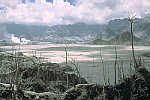 A pyroclastic flow will destroy nearly everything in its
path. With rock fragments ranging in size from ash to boulders traveling across
the ground at speeds typically greater than 80 km per hour, pyroclastic flows
knock down, shatter, bury or carry away nearly all objects and structures in
their way. The extreme temperatures of rocks and gas inside pyroclastic flows,
generally between 200°C and 700°C,
can cause combustible material to burn, especially petroleum products, wood,
vegetation, and houses.
A pyroclastic flow will destroy nearly everything in its
path. With rock fragments ranging in size from ash to boulders traveling across
the ground at speeds typically greater than 80 km per hour, pyroclastic flows
knock down, shatter, bury or carry away nearly all objects and structures in
their way. The extreme temperatures of rocks and gas inside pyroclastic flows,
generally between 200°C and 700°C,
can cause combustible material to burn, especially petroleum products, wood,
vegetation, and houses.
Pyroclastic flows vary considerably in size and speed, but
even relatively small flows that move <5 km from a volcano can destroy
buildings, forests, and farmland. And on the margins of pyroclastic flows, death
and serious injury to people and animals may result from burns and inhalation of
hot ash and gases.
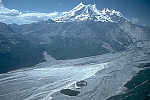 Pyroclastic flows generally follow valleys or other
low-lying areas and, depending on the volume of rock debris carried by the flow,
they can deposit layers of loose rock fragments to depths ranging from less than
one meter to more than 200 m. Such loose layers of ash and volcanic rock debris
in valleys and on hillslopes can lead to lahars indirectly by damming or blocking tributary streams, which may cause water to form a
lake behind the blockage, overtop and erode the blockage, and mix with the rock
fragments as it rushes downstream. Or, increasing
the rate of stream runoff and erosion during subsequent rainstorms. Hot
pyroclastic flows and surges can also directly generate lahars by eroding
and mixing with snow and ice on a volcano's flanks, thereby sending a sudden
torrent of water surging down adjacent valleys
Pyroclastic flows generally follow valleys or other
low-lying areas and, depending on the volume of rock debris carried by the flow,
they can deposit layers of loose rock fragments to depths ranging from less than
one meter to more than 200 m. Such loose layers of ash and volcanic rock debris
in valleys and on hillslopes can lead to lahars indirectly by damming or blocking tributary streams, which may cause water to form a
lake behind the blockage, overtop and erode the blockage, and mix with the rock
fragments as it rushes downstream. Or, increasing
the rate of stream runoff and erosion during subsequent rainstorms. Hot
pyroclastic flows and surges can also directly generate lahars by eroding
and mixing with snow and ice on a volcano's flanks, thereby sending a sudden
torrent of water surging down adjacent valleys
Tephra:
Volcanic Rock and Glass Fragments
 Tephra is a general term for
fragments of volcanic rock and lava regardless of size that are blasted
into the air by explosions or carried upward by hot gases in eruption
columns or lava fountains. Such fragments range in size from less than 2
mm (ash) to more than 1 m in diameter. Large-sized tephra typically
falls back to the ground on or close to the volcano and progressively
smaller fragments are carried away from the vent by wind. Volcanic ash,
the smallest tephra fragments, can travel hundreds to thousands of
kilometers downwind from a volcano.
Tephra is a general term for
fragments of volcanic rock and lava regardless of size that are blasted
into the air by explosions or carried upward by hot gases in eruption
columns or lava fountains. Such fragments range in size from less than 2
mm (ash) to more than 1 m in diameter. Large-sized tephra typically
falls back to the ground on or close to the volcano and progressively
smaller fragments are carried away from the vent by wind. Volcanic ash,
the smallest tephra fragments, can travel hundreds to thousands of
kilometers downwind from a volcano.
Mount
St. Helens's tephra: ash & pumice
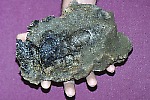 Tephra consists of a wide range of rock particles
(size, shape, density, and chemical composition), including combinations
of pumice, glass shards, crystals from different types of minerals, and
shattered rocks of all types (igneous, sedimentary, and metamorphic). A
great variety
of terms are used to describe the range of rock fragments thrown
into the air by volcanoes. The terms classify the fragments according to
size, shape, or the way in which they form and travel.
Tephra consists of a wide range of rock particles
(size, shape, density, and chemical composition), including combinations
of pumice, glass shards, crystals from different types of minerals, and
shattered rocks of all types (igneous, sedimentary, and metamorphic). A
great variety
of terms are used to describe the range of rock fragments thrown
into the air by volcanoes. The terms classify the fragments according to
size, shape, or the way in which they form and travel.
Kilauea's
tephra: reticulite
Volcanic
ash
Ash flow
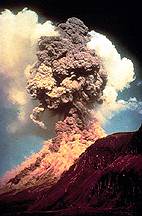 Ash
Flows are dense masses of
gas and tiny fragments of lava that flow down the sides of volcanoes at great
speeds.
Much less well known (and understood) than lava flows or explosive
blasts, ash flows are a combination a blast cloud and a lava flow. They form
when gas-saturated lavas comes near the surface of the Earth and the pressure in
the lava becomes low enough to allow the dissolved gas to form bubbles. If the
bubbles form fast enough, the lava breaks into tiny fragments of liquid rock
(called ash) that are carried out of the surface vent with the gas. If the ratio
of gas to fragments is large (lots of gas), the ash is carried by the gas into
blast clouds that can reach the upper atmosphere. If the ratio of gas to ash is
small (lots of fragments), the ash can drag the gas downward into red-hot flows.
These red-hot flows are partially controlled by gravity, and since the gas makes
the friction between the ash particles very small, they can flow very far (up to
hundreds of miles), very fast (over a hundred mph). The relatively small red-hot
ash flows that have been seen by geologists are called glowing avalanches
because of their similarities to snow avalanches. They
usually covers a large
area and disrupts the lives of far more people than the other more lethal
types of volcano hazards. Unfortunately, the size of ash particles that
fall to the ground and the thickness of ashfall downwind from an erupting
volcano are difficult to predict in advance. Not only is there a wide
range in the size of an eruption that might occur and the amount of tephra
injected into the atmosphere, but the direction and strength of the
prevailing wind can vary widely.
The photo above is by Courtesy of NGDC/NOAA.
Ash
Flows are dense masses of
gas and tiny fragments of lava that flow down the sides of volcanoes at great
speeds.
Much less well known (and understood) than lava flows or explosive
blasts, ash flows are a combination a blast cloud and a lava flow. They form
when gas-saturated lavas comes near the surface of the Earth and the pressure in
the lava becomes low enough to allow the dissolved gas to form bubbles. If the
bubbles form fast enough, the lava breaks into tiny fragments of liquid rock
(called ash) that are carried out of the surface vent with the gas. If the ratio
of gas to fragments is large (lots of gas), the ash is carried by the gas into
blast clouds that can reach the upper atmosphere. If the ratio of gas to ash is
small (lots of fragments), the ash can drag the gas downward into red-hot flows.
These red-hot flows are partially controlled by gravity, and since the gas makes
the friction between the ash particles very small, they can flow very far (up to
hundreds of miles), very fast (over a hundred mph). The relatively small red-hot
ash flows that have been seen by geologists are called glowing avalanches
because of their similarities to snow avalanches. They
usually covers a large
area and disrupts the lives of far more people than the other more lethal
types of volcano hazards. Unfortunately, the size of ash particles that
fall to the ground and the thickness of ashfall downwind from an erupting
volcano are difficult to predict in advance. Not only is there a wide
range in the size of an eruption that might occur and the amount of tephra
injected into the atmosphere, but the direction and strength of the
prevailing wind can vary widely.
The photo above is by Courtesy of NGDC/NOAA.
Ash flows
ultimately stop because the gas finally escapes from between the particles.
Glowing avalanches usually leave thin deposits of loose fragments like sand
mixed with gravel. The ash fragments are hot, however, and deposits of ash have
been found which are so thick that the hot particles actually fused together to
form solid masses of rock after they stopped flowing. Geologists have never
actually watched the formation of such a deposit, but the amount of ash in these
deposits is so large that it requires ash flows hundreds of times larger than
the glowing avalanches that have been seen. The destructive power in ash flows
is a result of both the high flow speed and the high temperatures of the gas and
fragmented rock. Even relatively small ash flows can be incredibly destructive:
a glowing avalanche destroyed the town of St. Pierre in less than 30 seconds.
The force of the flow literally ripped buildings apart all over town; only the
sturdiest of stone walls were left standing. All but two of the 30,000
inhabitants of St. Pierre were asphyxiated or burned to death by the dense,
superhot cloud. Ash flows occur in explosive eruptions and have been a
significant problem with eruptions in Japan and the American Cascades.
Ash Falls
are less devastating than ash flows but can be very disruptive to modern life.
Ash falls are the blanketing deposits dropped downwind by the clouds of ash
thrown into the atmosphere by explosive volcanoes. These deposits may be a thin
dusting or a thick layer of grit. They appear grayish to whitish and look like
fallen snow, but, unlike snow, ash deposits do not melt and must be physically
removed. The ash is heavy and can collapse roofs, break branches, and coat the
leaves of plants. Unless the plants are cleaned (manually or by rain), they can
die. This is a significant problem for crops. The ash is particularly hard on
machines. Some ash particles are so small that they can pass through the
engine's air filters and ruin the engine.
Potential Effects of Volcanic Ash
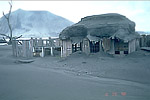
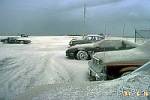 Volcanic ash is highly disruptive to economic activity
because it covers just about everything, infiltrates most openings, and is
highly abrasive. Airborne ash can obscure sunlight to cause temporary darkness
and reduce visibility to zero. Ash is slippery, especially when wet; roads,
highways, and airport runways may become impassable. Automobile and jet engines
may stall from ash-clogged air filters and moving parts can be damaged from
abrasion, including bearings, brakes, and transmissions. Roofs
may collapse from added weight, farmland
will be covered,
power systems may shut down, waste water systems may clog, gutters may fill and collapse...
The image USGS EROS Data Center by on the right shows the ash layer on cars
near Mount Pinatubo.
Volcanic ash is highly disruptive to economic activity
because it covers just about everything, infiltrates most openings, and is
highly abrasive. Airborne ash can obscure sunlight to cause temporary darkness
and reduce visibility to zero. Ash is slippery, especially when wet; roads,
highways, and airport runways may become impassable. Automobile and jet engines
may stall from ash-clogged air filters and moving parts can be damaged from
abrasion, including bearings, brakes, and transmissions. Roofs
may collapse from added weight, farmland
will be covered,
power systems may shut down, waste water systems may clog, gutters may fill and collapse...
The image USGS EROS Data Center by on the right shows the ash layer on cars
near Mount Pinatubo.
Explosive blast
The
Explosive Blast is the
"Feature Presentation" of a explosively erupting volcano.
It is an outburst of fragments of rock and lava driven by expanding gases which
were dissolved in the erupting lava at great depths. These blasts may throw
great blocks of rock many miles. However, the superheated blast cloud itself,
which expands out from the volcano at hundreds of miles per hour, enveloping and
searing anything in its path is more destructive. The destructive power of the
blasts lies in the high velocity winds (exceeding wind speeds in hurricanes)
within the cloud and the very high temperatures of the gas. The blasts are
capable of destroying all life within many miles of the volcano in a matter of
minutes. The main blast at Mount St. Helens destroyed more than 230 square miles of forest in a few seconds.
Glacial
Outbursts
Glacial
Outbursts as the name
suggests, are masses of water or ice suddenly released from a glacier. Outbursts
may be caused by rapid melting, an earthquake, or heat from lava moving inside a
volcano. Glacial outbursts are primarily water, but they can turn into mudflows
if they flow over ground with abundant soil or gravel. Glacial outbursts and
mudflows can occur on any mountain with glaciers or heavy snow pack, but since
many volcanoes grow to altitudes at which glaciers form, outbursts and mudflows
are frequently significant volcano-related hazards as well.
Earthquakes
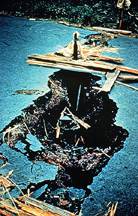 Some, but not all, earthquakes are related to volcanoes.
For example, most earthquakes are along the edges of tectonic plates. This is
where most volcanoes are too. However, most earthquakes are caused by the
interaction of the plates not the movement of magma. Earthquakes
around volcanoes are caused by movement of lava inside the volcano. The lava
literally pushes rock aside as it moves underground. The rock is brittle and
breaks as it is moved, releasing seismic energy that we record as earthquakes.
Most of the earthquakes are small to medium in size. When they occur in large
groups during a short period of time, they are called swarms. These occur often
and can keep the ground continuously shaking for long periods of time. Some
earthquakes can be large, such as the 5.1-magnitude earthquake that started the
May 18 eruption of Mount St. Helens which was the result of the north half of
the mountain breaking free. The photo on the left is taken by Courtesy of NGDC/NOAA.
Some, but not all, earthquakes are related to volcanoes.
For example, most earthquakes are along the edges of tectonic plates. This is
where most volcanoes are too. However, most earthquakes are caused by the
interaction of the plates not the movement of magma. Earthquakes
around volcanoes are caused by movement of lava inside the volcano. The lava
literally pushes rock aside as it moves underground. The rock is brittle and
breaks as it is moved, releasing seismic energy that we record as earthquakes.
Most of the earthquakes are small to medium in size. When they occur in large
groups during a short period of time, they are called swarms. These occur often
and can keep the ground continuously shaking for long periods of time. Some
earthquakes can be large, such as the 5.1-magnitude earthquake that started the
May 18 eruption of Mount St. Helens which was the result of the north half of
the mountain breaking free. The photo on the left is taken by Courtesy of NGDC/NOAA.
Tidal Waves
Tidal Waves
are giant water waves that form when volcanoes erupt in or near large bodies of
water. Waves can be caused by large earthquakes associated with the volcano, by
movement of seafloor rocks during caldera eruptions, by giant rock avalanches,
or by boiling or expuling water out of a hot, collapsed crater.
Lightning?
 Yes, during a volcanic eruption lightning is often
observed in the eruption cloud. We don't completely understand
regular lightning and volcanic lightning is similarly not
understood. It must have something to do with all the particles of ash in the
cloud moving around and bumping into each other, producing strong static charges
(similar to how rubing a comb across the carpet produces static charges).
Yes, during a volcanic eruption lightning is often
observed in the eruption cloud. We don't completely understand
regular lightning and volcanic lightning is similarly not
understood. It must have something to do with all the particles of ash in the
cloud moving around and bumping into each other, producing strong static charges
(similar to how rubing a comb across the carpet produces static charges).
Common
questions about volcanoes' impact
How do volcanoes affect the atmosphere and
climate?
There are two things to think about. The first is how the
weather near an erupting volcano is being affected. The second is how large
eruptions will affect the weather/climate around the world. I think more people
are worried about the second issue than the first.
 The main effect on weather right near a
volcano is that there is often a lot of rain, lightning, and thunder during an
eruption. This is because all the ash particles that are thrown up into the
atmosphere are good at attracting/collecting water droplets. We don't quite know
how the lightning is caused but it probably involves the particles moving
through the air and separating positively and negatively charged particles. Another problem in
Hawaii
involves the formation of vog, or volcanic fog. The ongoing eruption is very
quiet, with lava flowing through lava tubes and then into the ocean. Up at the
vent is an almost constant plume of volcanic fume that contains a lot of sulfur
dioxide. This SO2 combines with water in the atmosphere to form
sulfuric acid droplets that get carried in the trade winds around to the leeward
side of the Big Island. The air quality there has been really poor since the
eruption started in 1983 and they are getting pretty tired of it.
The main effect on weather right near a
volcano is that there is often a lot of rain, lightning, and thunder during an
eruption. This is because all the ash particles that are thrown up into the
atmosphere are good at attracting/collecting water droplets. We don't quite know
how the lightning is caused but it probably involves the particles moving
through the air and separating positively and negatively charged particles. Another problem in
Hawaii
involves the formation of vog, or volcanic fog. The ongoing eruption is very
quiet, with lava flowing through lava tubes and then into the ocean. Up at the
vent is an almost constant plume of volcanic fume that contains a lot of sulfur
dioxide. This SO2 combines with water in the atmosphere to form
sulfuric acid droplets that get carried in the trade winds around to the leeward
side of the Big Island. The air quality there has been really poor since the
eruption started in 1983 and they are getting pretty tired of it.
As for the world-wide affects of volcanic eruptions this
only happens when there are large explosive eruptions that throw material into
the stratosphere. If it only gets into the troposphere it gets flushed out by
rain. The effects on the climate haven't been completely figured out. It seems
to depend on the size of the particles (again mostly droplets of sulfuric acid).
If they are big then they let sunlight in but don't let heat radiated from the
Earth's surface out, and the net result is a warmer Earth (the famous Greenhouse
effect). If the particles are smaller than about 2 microns then they block some
of the incoming energy from the Sun and the Earth cools off a little. That seems
to have been the effect of the Pinatubo eruption where about a 1/2 degree of
cooling was noticed around the world. Of course that doesn't just mean that
things are cooler, but there are all kinds of effects on the wind circulation
and where storms occur. Some people think that large eruptions can cause the
weather phenomena called "El Nino" to start. This is a huge disruption
of the Earth's atmospheric circulation. The connection hasn't been accepted by
everybody though. An even more controversial connection involves whether or
not volcanic activity on the East Pacific Rise (a mid-ocean spreading center)
can cause warmer water at the surface of the East Pacific, and in that way
generate an El Nino. Dr. Dan Walker at the University of Hawaii has
noticed a strong correlation between seismic activity on the East Pacific Rise
(which he presumes indicates an eruption) and El Nino cycles over the past ~25
years.
As a long-term average, volcanism
produces about 5X10^11 kg of CO2 per year; that production, along
with oceanic and terrestrial biomass cycling maintained a carbon dioxide
reservoir in the atmosphere of about 2.2X10^15 kg. Current fossil fuel and land
use practices now introduce about a (net) 17.6X10^12 kg of CO2 into
the atmosphere and has resulted in a progressively increasing atmospheric
reservoir of 2.69X10^15 kg of CO2. Hence, volcanism produces about 3%
of the total CO2 with the other 97% coming from anthropogenic
sources.
How do
volcanoes affect plants and animals?
Livestock and other mammals have been killed by lava
flows, pyroclastic flows, tephra falls, atmospheric effects, gases, and tsunami.
They can also die from famine, forest fires, and earthquakes caused by or
related to eruptions. Mount St. Helens provides an example. The Washington
Department of Game estimated that 11,000 hares, 6,000 deer, 5,200 elk, 1,400
coyotes, 300 bobcats, 200 black bears, and 15 mountain lions died from the
pyroclastic flows of the 1980 eruption. Aquatic life can be affected by an increase in acidity,
increased turbidity, change in temperature, and/or change in food supply. These
factors can damage or kill fish. Eruptions can influence bird migration, roosting, flying
ability, and feeding activity. The impact of eruptions on insects depends on the size of
the eruption and the stage of growth of the insect. For example, ash can be very
abrasive to wings.
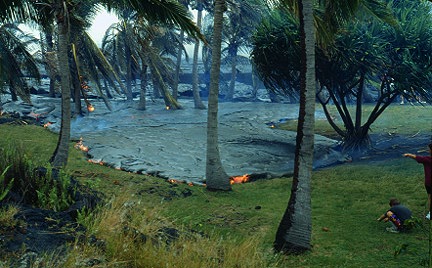 Plants are destroyed over a wide area, during an eruption.
The good thing is that volcanic soil is very rich, so once everything cools off,
plants can make a big comeback! How quickly do plants begin to grow back? The answer is
that it depends on how much rain falls in the particular area. For example, on
the rainy side of the island of Hawaii, flows that are only 2 years old already
have ferns and small trees growing on them. Probably in 10 years they'll be
covered by a low forest. On the dry side of Hawaii there are flows a couple
hundred years old with hardly a tuft of grass in sight. This means that when you
are looking at old lava flows and trying to determine how old they are based on
the amount of vegetation, you have to take the climate into effect as well.
Plants are destroyed over a wide area, during an eruption.
The good thing is that volcanic soil is very rich, so once everything cools off,
plants can make a big comeback! How quickly do plants begin to grow back? The answer is
that it depends on how much rain falls in the particular area. For example, on
the rainy side of the island of Hawaii, flows that are only 2 years old already
have ferns and small trees growing on them. Probably in 10 years they'll be
covered by a low forest. On the dry side of Hawaii there are flows a couple
hundred years old with hardly a tuft of grass in sight. This means that when you
are looking at old lava flows and trying to determine how old they are based on
the amount of vegetation, you have to take the climate into effect as well.
Lava
flows covering the Kamoamoa area of Hawaii Volcanoes National Park. Photograph
by Steve Mattox, November 14, 1992.
The long-term
effects of an eruption on wildlife are usually quite small. Certainly at Mt. St.
Helens scientists saw that both plants and animals returned to the utterly
devastated areas within only a year or so of the eruption. It is usually the short-term effects that are really bad.
For example, there was a very big eruption of Santa Maria volcano (Guatemala) in
1902. The eruption itself killed a few hundred to perhaps 1500 people as well as
thousands of birds. Pretty soon there were so many insects including
disease-carrying mosquitoes that eventually 3000-6000 people died from malaria.
As
for the dinosaurs, there are various variations on the main
theory. In general it is proposed that volcanic activity put so much ash and/or
gas into the atmosphere that the earth's temperature either got too hot for the
dinosaurs or got too cold for the dinosaurs. It sounds kind of funny that either
can happen but it is true. If the ash particles are really small (<2 microns)
then they block out incoming sunlight and the earth gets cool. If they are
bigger than 2 microns (but still pretty small) then they let sunlight in but
don't let heat radiation from the surface out, and the earth gets warm.
Anyway, if you have enough large explosive eruptions, then
the theory says that there will be enough ash in the stratosphere to have one of
these effects. You need an eruption (or series of eruptions) that is much bigger
than anything we have ever witnessed. The reason that you need to put the ash
into the stratosphere is that if it is only in the troposphere (where weather
clouds are), then it will get rained out very quickly and it won't be around
long enough to have a climatic effect. Of course the more famous idea is that a huge meteorite
came in and hit the earth, throwing up enough gas and dust into the stratosphere
to have the same heating or cooling effect. One line of support for this is that
at the geologic time boundary where the dinosaurs died out (the
Cretaceous-Tertiary boundary) there is a layer of clay that is rich in an
element called iridium. Iridium is not very common on Earth, but it is proposed
to be more abundant in asteroids and meteorites. One way to produce such a layer
at the same instant that the dinosaurs died out is therefore to have a meteorite
bring it in. One major problem with the volcanic hypothesis is that
volcanoes, especially the explosive ones, don't produce much iridium. Basaltic
volcanoes, such as those in Hawaii produce more iridium but they are not
very explosive.
A more recent idea that tries to get around these problems
is that instead of a huge explosive eruption, you have a long-term basaltic
eruption that mainly puts SO2 gas into the troposphere. The gas will
be converted into small droplets of sulfuric acid which will block incoming
sunlight. Because it is only in the troposphere much of the acid may get rained
out, but if you have an eruption that continues long enough it can keep up with
the rain to produce an Earth-covering haze. What kind of eruption might this be? There are places on
Earth where huge volumes of basaltic lavas are found. They are called flood
basalts, and the most famous are the Columbia River Basalts in
Washington/Oregon, and the Deccan Traps in India. The name "flood
basalts" gives an indication of how most people consider them to be
erupted, namely as huge fast-moving floods of basalt. However, recent work by a
number of scientists at the University of Hawai'i have shown that these
flood basalts look more like the slow-moving type of basalt lava (pahoehoe) than
the fast-moving type (aa). This leads next to the conclusion that perhaps
these flood basalts were not emplaced as huge floods in short periods of time
but rather as slower-moving flows over a long period of time (such as 1-2
hundred years). The eruptions would still have been much bigger than those we
see here in Hawaii, however. This new idea thus provides a long-term source for lots of
SO2, and a possible explanation for the iridium (which, again, is found in
basalt lava). It wasn't the Columbia River Basalts that were the cause for the
dinosaur extinction because the dinosaurs disappeared about 65 million years
ago, and the Columbia River Basalts are only about 12 million years old. Perhaps
it was the eruption of the Deccan traps, since their age is about right.

 Many kinds of volcanic activity can endanger the
lives of people and property both close to and far away from a volcano.
Most of the activity involves the explosive ejection or flowage of rock
fragments and molten rock in various combinations of hot or cold, wet or
dry, and fast or slow. Some hazards are more severe than others
depending on the size and extent of the event taking place and whether
people or property are in the way. And although most volcano hazards are
triggered directly by an eruption, some occur when a volcano is quiet.
Many kinds of volcanic activity can endanger the
lives of people and property both close to and far away from a volcano.
Most of the activity involves the explosive ejection or flowage of rock
fragments and molten rock in various combinations of hot or cold, wet or
dry, and fast or slow. Some hazards are more severe than others
depending on the size and extent of the event taking place and whether
people or property are in the way. And although most volcano hazards are
triggered directly by an eruption, some occur when a volcano is quiet.


 House partially buried by lahar deposits downstream from Unzen Volcano, Japan
House partially buried by lahar deposits downstream from Unzen Volcano, Japan











 Ash
Flows are dense masses of
gas and tiny fragments of lava that flow down the sides of volcanoes at great
speeds.
Ash
Flows are dense masses of
gas and tiny fragments of lava that flow down the sides of volcanoes at great
speeds.

 Some, but not all, earthquakes are related to volcanoes.
For example, most earthquakes are along the edges of tectonic plates. This is
where most volcanoes are too. However, most earthquakes are caused by the
interaction of the plates not the movement of magma.
Some, but not all, earthquakes are related to volcanoes.
For example, most earthquakes are along the edges of tectonic plates. This is
where most volcanoes are too. However, most earthquakes are caused by the
interaction of the plates not the movement of magma. Yes, during a volcanic eruption lightning is often
observed in the eruption cloud. We don't completely understand
regular lightning and volcanic lightning is similarly not
understood. It must have something to do with all the particles of ash in the
cloud moving around and bumping into each other, producing strong static charges
(similar to how rubing a comb across the carpet produces static charges).
Yes, during a volcanic eruption lightning is often
observed in the eruption cloud. We don't completely understand
regular lightning and volcanic lightning is similarly not
understood. It must have something to do with all the particles of ash in the
cloud moving around and bumping into each other, producing strong static charges
(similar to how rubing a comb across the carpet produces static charges).
 Plants are destroyed over a wide area, during an eruption.
The good thing is that volcanic soil is very rich, so once everything cools off,
plants can make a big comeback!
Plants are destroyed over a wide area, during an eruption.
The good thing is that volcanic soil is very rich, so once everything cools off,
plants can make a big comeback!